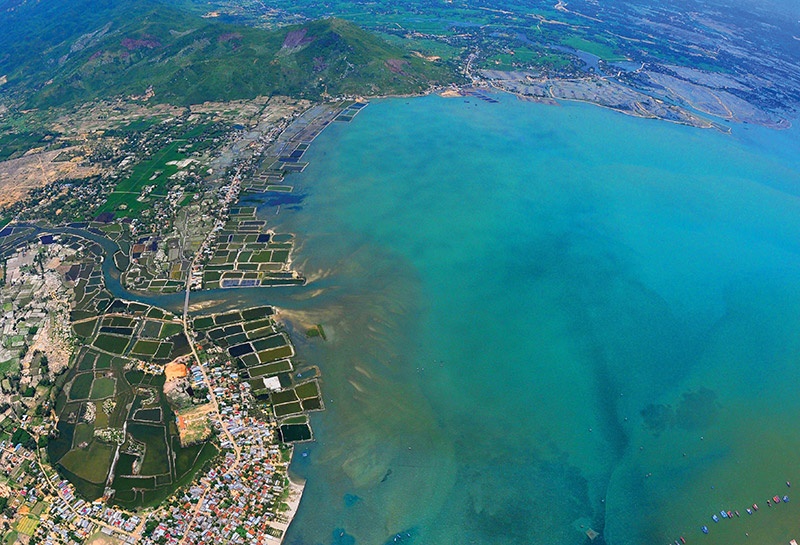Doing our part to frame the planet’s harmonious future
 |
| Caitlin Wiesen, resident representative of the United Nations Development Programme in Vietnam |
Our planet is facing a triple planetary emergency: the climate is heating up much faster than anticipated; habitat loss and other pressures are leading to an estimated one million species being threatened with extinction; and the pollution of our air, land, and water is intensifying and expanding.
We need to take more radical and concerted efforts to transform our economies and societies to make them green, inclusive, and more connected with nature. We must shift from harming the planet to healing it as a matter of utmost urgency, as Achim Steiner, administrator of the United Nations Development Programme (UNDP) stated, “The world must invest more time, energy, and understanding of how much species, biodiversity, and ecosystems matter to our future”.
Fifty years ago, the first UN Conference on the Human Environment was held in Stockholm. This year, the world is taking stock of the key challenges that people and the planet are facing and have met in Stockholm this week to assess best solutions and actions to overcome these challenges. The UNDP in Vietnam has been working with the Embassy of Sweden and the Ministry of Natural Resources and Environment to facilitate the Stockholm+50 consultation process to bring the views of the Vietnamese people to the global stage.
Given Vietnam’s climate commitment at COP26, the country is now at a crossroads as it seeks to transform growth and development in ways that benefit both the economy and the environment. This includes green, climate-resilient approaches to technology, capital markets, supply chains, business models, and the engagement of small- and medium-sized enterprises in innovation.
Vietnam will need a “green climate doi moi” to enable a green and inclusive economic rebound as the country strives for a high-income level by 2045 while safeguarding natural resources and the environment for future generations.
The recently launched draft National Climate Change Strategy is one of the key policy instruments for Vietnam to deliver its net-zero emission target by 2050 and to build community resilience. The UNDP will continue to support Vietnam in reviewing its Nationally Determined Contributions and the technical report of the National Adaptation Plan prior to COP27 in November this year.
Just energy transition
One of the top government priorities is a just energy transition. Vietnam’s robust economic growth requires an even higher growth in energy production. Vietnam has great potential for renewable energy, especially solar and offshore wind. Expanding renewable energy will help to sustainably power the economy, increase energy security and transform many other economic sectors into green development pathways, for example in the transport sector.
However, there are several practical impediments to achieving a green and just transition, such as the legal framework (including pricing) of electricity; transmission systems; regional markets; and securing financing. The UNDP stands ready to support Vietnam in this mission, including the phasing out of coal highlighted during the recent exchange between Prime Minister Pham Minh Chinh and UNDP administrator Achim Steiner, and in the letter conveyed by the UN Secretary-General António Guterres and Prime Minister Chinh.
A key but often overlooked dimension of green growth is the vital role of the ocean economy for the sustainable development of Vietnam. The ocean is the main climate regulator we have. It offers clean energy and sustains us with many critical resources. The blue economy contributes to climate change mitigation by developing offshore renewable energies, decarbonising maritime transport and greening ports.
Also, developing green infrastructure in coastal areas will help preserve biodiversity and landscapes, while bringing about benefits to the coastal economy, including tourism. Marine spatial planning is essential to providing a framework for the sustainable use of natural resources and ecosystem services derived from the sea areas.t
It is also critical for enhancing global action to address plastic pollution, and accelerating progress toward an international legally-binding instrument on plastic pollution to prevent and reduce the environmental impact of plastic pollution, in line with the UN Environment Assembly Resolution on ending plastic pollution.
The UNDP is proud to have worked closely with the Vietnamese government in initiating important steps for promoting the blue economy, marine spatial planning, and combating marine plastic and we look forward to the finalisation of the Marine Spatial Master Plan that will help unleash offshore wind potential while protecting the Ocean.
 |
Long-lasting benefits
The UNDP is also proud to work in close partnership with Vietnam over the years in natural resources management and biodiversity conservation to protect various ecosystems from forests and wetlands to coral reefs. We see many important opportunities for Vietnam to overcome current challenges using nature-based solutions through reforestation, sustainable forest management, mangrove plantation and rehabilitation, and nature-based tourism.
Specifically, mangroves are among the most effective nature-based solutions; not only are they a source of sustainable livelihoods such as aquaculture and beekeeping, but they also contribute to carbon sequestration, biodiversity conservation, coastal protection, and water filtration. They create a common benefit, both for reducing global climate change impacts and helping people to improve their livelihoods, as well as to increase the forest cover rate in Vietnam.
Last but not least, securing innovative long-term financing for Vietnam’s decarbonisation programmes will be crucial for reaching carbon neutrality. International experience provides examples of institutional and policy innovations to achieve this, including national development banks, various incubator programmes, sovereign wealth funds, and green bonds that can help to ‘crowd in’ private financing and mobilise global climate finance.
Vietnam must introduce a transparent policy framework on green financing flows to support new green and resilient projects and investments. Both foreign direct investment and domestic private sector finance are essential to support the achievement of the net-zero emissions target by 2050.
Our one and only planet is facing serious risks – a fast-changing climate, increasing marine plastic pollution, and loss of biodiversity and ecosystems. Time is running out, and nature is in emergency mode. We need urgent action to address these pressing issues.
While many of these options can only be advanced by larger entities with the power to rewrite the rules and frame our ambition, each and every one of us can do our part to ensure this unique and beautiful planet remains a comfortable home for humanity and nature in harmony and balance.
And this is where the partnerships and cooperation between the UN and the Vietnamese government, international and national organisations, and also communities have become more vital than ever before.
The UNDP looks forward to ever stronger partnership with the Vietnamese government to address the challenges of climate change, especially in accelerating a green, inclusive, circular economy, and boosting biodiversity conservation to build a resilient future for all.
| Marine renewable energy The exploitation of marine renewable energy sources, and offshore wind power in particular, is still a very new field in Vietnam. The number of investment projects and exploitation of wind power offshore and on islands in Vietnam is still very low. Apart from offshore wind, other forms of marine energy, such as tidal power, ocean waves, and ocean currents are still in the research stage but are considered potential energy sources. However, in recent years, the investment, construction, and operation of renewable energy power projects have risen in popularity. The explosion of registrations for solar and wind projects is driven by two basic reasons: firstly is the rapid advancement of solar and wind power generation technology, making construction and equipment installation cheaper and which reduces electricity production cost per unit. Secondly is the strengthening of mechanisms and policies to encourage investment, especially the purchase price of electricity from solar and wind power from the Vietnamese government. Therefore, even though the share of offshore wind in total electricity output is currently modest, if this growth rate is maintained, the share of renewable energy which comes from offshore wind will certainly be much larger than today. Vietnam is evaluated as a country with a relatively high potential for diverse renewable energy sources, including solar energy, wind energy (including offshore wind power), tidal energy, ocean waves, and ocean currents. Solar energy is available around the year, is relatively stable, and is widely spread throughout various geographical and climate zones. Solar energy, especially in the central and southern regions, can be used 300 days a year on average. In the central and southern regions, the average solar radiation is five kWh per square metre a day. Meanwhile, in the north, the solar radiation is about four kWh per sq.m a day. Meanwhile, the East Sea provides a high potential for marine energy through wave power, ocean current power, and tide power of at least 500MW a year. Though these technologies have not yet matured, they may become one element of a mix of power generation in Vietnam in the upcoming decades. Furthermore, as a coastal country in a monsoon tropical zone, Vietnam is considered to have very good potential for offshore wind energy. However, like in other developing countries, this potential is not yet quantified at a reliable level because of a lack of wind measurement data and current data sources for wind. Source: United Nations evelopment Prgramme |
What the stars mean:
★ Poor ★ ★ Promising ★★★ Good ★★★★ Very good ★★★★★ Exceptional
Related Contents
Latest News
More News
- CSI 2025 highlights rise of Vietnam’s green champions (December 06, 2025 | 09:00)
- Vietnam’s forest carbon credits draw global interest (December 05, 2025 | 17:41)
- Coro Energy to launch BESS Pilot in Vietnam (December 04, 2025 | 15:12)
- Vietnam strengthens energy storage pathway (December 04, 2025 | 15:05)
- Women take leading role in agriculture and food systems (December 03, 2025 | 19:04)
- Experts highlight unpaid care work as key barrier to gender equality (December 03, 2025 | 15:15)
- Vietnam sets pace for dual transition in industry and trade (December 03, 2025 | 14:12)
- Harnessing technology for a sustainable future in Vietnam (December 03, 2025 | 12:17)
- Sustainability efforts on right track through policy and tech (December 03, 2025 | 12:05)
- Hanoi symposium highlights gender equality research and policy (December 03, 2025 | 12:00)

 Tag:
Tag:




















 Mobile Version
Mobile Version